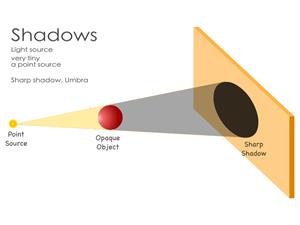
PUMPA - SMART LEARNING
எங்கள் ஆசிரியர்களுடன் 1-ஆன்-1 ஆலோசனை நேரத்தைப் பெறுங்கள். டாப்பர் ஆவதற்கு நாங்கள் பயிற்சி அளிப்போம்
Book Free DemoWhen light is allowed to fall on an opaque object, some areas located behind the opaque object, do not receive light rays and thus it forms the shadow of the object.
When light is passed on an opaque object, two kinds of shadows form behind the object. They are
- Core shadow
- Cast shadow

Formation of shadow
- The portion of the object that doesn't receive light is said to be the core shadow.
- Cast shadow is located on the surface behind the object that doesn't receive light.
- The space between the core shadow and cast shadow is called 'cone shadow'.
Now, we will discuss umbra and penumbra
A Cast and core shadows consist of two regions. They are
- Umbra
- Penumbra.
A region of partial darkness which surrounds the umbra is called penumbra.

Umbra and Penumbra
Properties of shadows:
- The opaque objects form shadows when light rays fall on them, the others (transparent and translucent) do not form shadows.
- Shadows always form in the opposite side of the light source.
- Shadows formed by objects cannot determine the characteristics of an object.
- Shadows formed by objects will always be dark whatever may be the colour of light rays fall on it.
- Light source, opaque objects, and shadows lie in a straight line.
- The shadow size depends upon the distance between light source and object and the distance between the object and the screen.